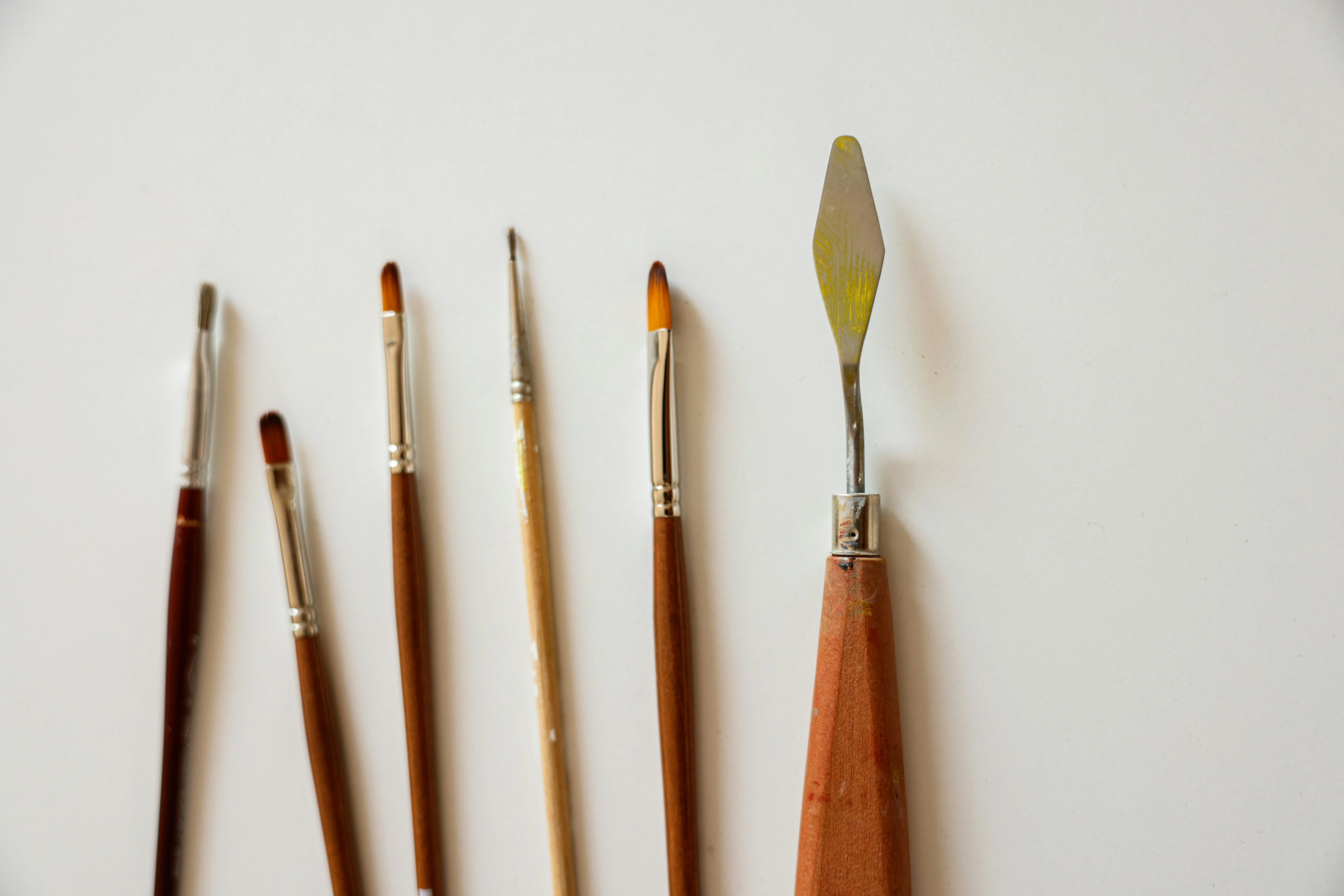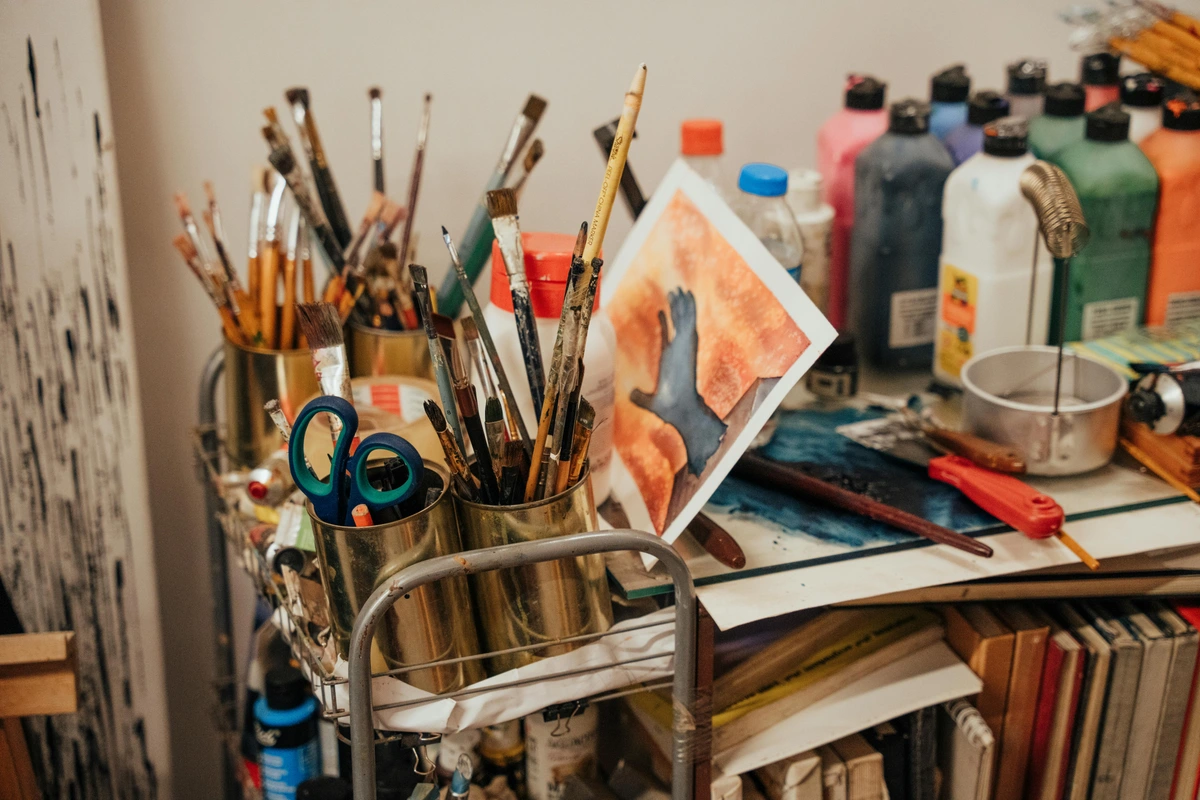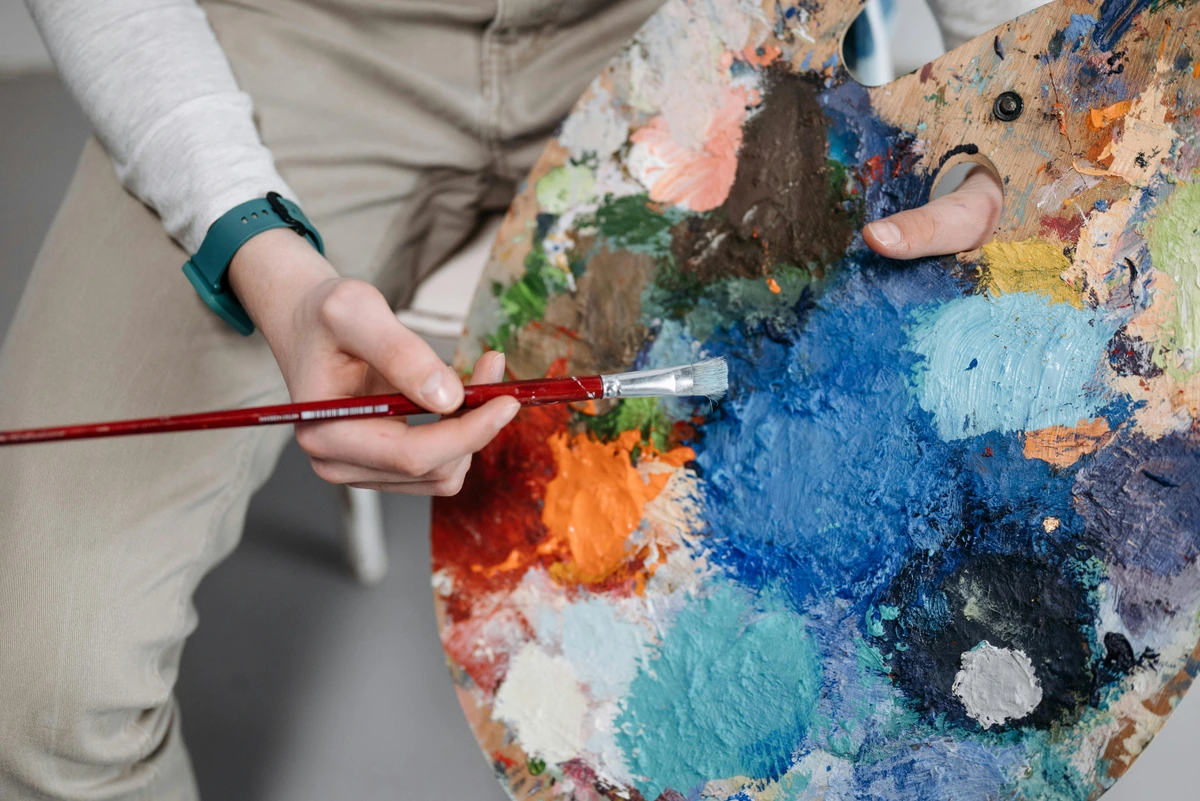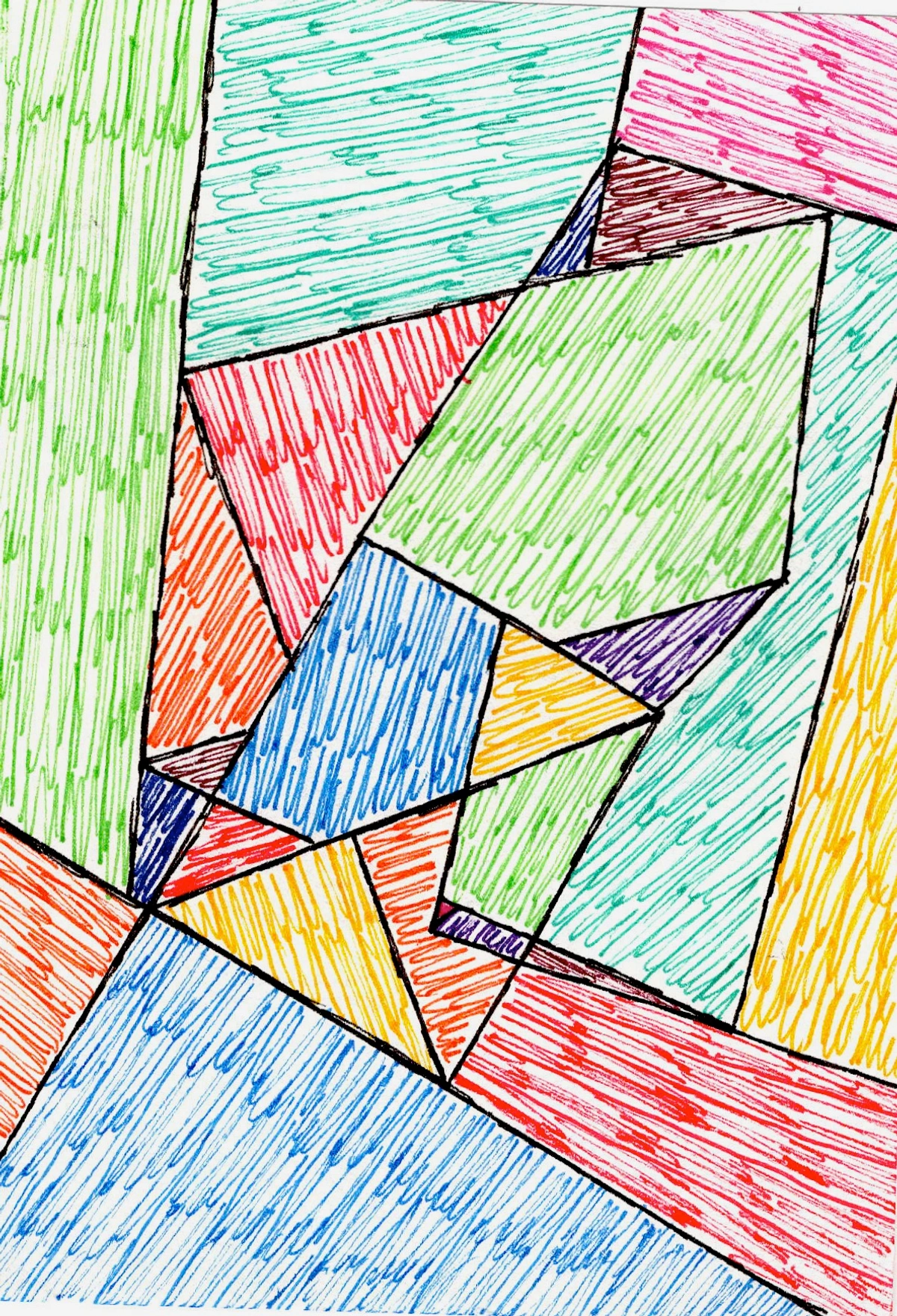
Acrylic Paint Brushes: An Artist's Unfiltered Guide to Synthetics, Essential Shapes, and Lasting Care
Unlock your acrylic art potential with this unfiltered guide. Discover why synthetic brushes are superior, master essential shapes for expressive painting, learn how to build your collection, and get crucial care tips for lifelong tools.
Acrylic Paint Brushes: An Artist's Unfiltered Guide to Synthetics, Essential Shapes, and Lasting Care
Alright, let's talk brushes. I'll confess: for years, I treated my paint brushes like an afterthought – the forgotten stepchildren of my art supplies, shoved into a coffee mug with no ceremony. I'd spend good money on vibrant acrylics, a decent canvas, and then just grab whatever dusty, splayed-out brush was closest. "It'll do!" I'd tell myself, and my early abstract work, bless its heart, probably suffered for it. It's funny how we expect so much from our paint, yet sometimes overlook the very thing that translates our vision onto the surface, isn't it? My brushes were often ruined through sheer negligence, a mistake I'm still learning from. This guide isn't about rigid rules, but about helping you choose the right allies for your vibrant, expressive acrylic journey. By the end, you'll understand which brushes are your true partners in creating something amazing, whether you're tackling abstract landscapes or delicate representational details, why synthetics are the undeniable champions, how to build your toolkit, and crucially, how to care for these essential extensions of your artistic intention.
The Brush Revelation: More Than Just Hairs on a Stick
I remember a particular afternoon in my studio – a delightful mess of creativity – where I was fighting with a painting. The paint was behaving like a stubborn toddler, refusing to blend where I wanted it to, making clunky marks, and I was just... frustrated. I was trying to achieve a soft, atmospheric blend for a background, but the tired, splayed bristles of my old brush just pushed the paint around in chunky streaks. It lacked any sort of spring, felt like a soggy noodle. That's when it hit me, clear as day: it was the brush. That tired, soggy noodle of a brush was sabotaging my efforts. That's when I finally understood that a brush isn't just a tool; it's a vital extension of your artistic intention. It’s the conduit for your thoughts, your emotions, your very essence, reaching the canvas. Sounds dramatic, I know, but trust me on this – the right brush, with its ability to maintain consistent paint application and precise marks, can truly transform your creative process. It's the silent partner that whispers your intentions onto the canvas, translating the abstract into the tangible. After all, how can you express nuanced emotion if your brush can’t even hold a consistent edge or apply paint smoothly?

The Great Debate: Synthetic vs. Natural for Acrylics
For acrylic painting, this isn't much of a debate for me. My vote, hands down, goes to synthetic brushes. And here's why, beyond just personal preference:
Natural hair brushes, though undeniably lovely for oils or watercolors, just don't play nice with acrylics. For oils, their natural scales hold the thick pigment beautifully, offering a unique drag and blending capability. For watercolors, they soak up and release water in a controlled, luxurious way. But with acrylics, their tendency to soak up the water-based paint, get gummy and clumpy, feeling more like a damp sponge than a tool for expressive strokes, is a major drawback. This gunking up is largely due to how the acrylic polymer binders in the paint can get trapped in the natural hair's rough cuticles, leading to quick deterioration and a frustratingly inconsistent application. Cleaning them? A nightmare. Plus, they can lose their shape and that essential 'spring' (or snap, as some call it – that satisfying bounce-back of the bristles that gives you control and responsiveness) after a few vigorous sessions. Without it, you feel like you're trying to paint with a wet noodle, which is about as effective as it sounds. Think of snap like the satisfying recoil of a perfectly tensioned rubber band, giving you immediate feedback. While some artists might initially prefer the familiar feel of natural bristles or a specific texture they can achieve, for acrylics, the downsides often outweigh any perceived benefits in the long run.

Synthetic fibers, on the other hand, are engineered to handle acrylics. They're typically made from durable materials like specialized nylon (often called Taklon) or polyester blends, meticulously designed to mimic the qualities of natural hair – like softness or stiffness – but without the drawbacks. Different synthetic blends can offer varied characteristics, from incredibly soft and absorbent (for washes) to stiff and resilient (for impasto), giving artists precise control over how paint is moved and applied. They're incredibly resilient, retain their shape beautifully even after repeated washing, and handle the unique viscosity (that's the thickness and flow) of acrylics like a dream. Imagine trying to stir honey versus water – that difference in resistance is viscosity. Because their fibers are smooth and non-absorbent, they move the paint without absorbing too much, meaning they perform consistently whether you're working with thick heavy body paints, fluid acrylics, or even inks, offering superior paint release and control. And, crucially, they clean up so easily. Let's be honest, clean-up is a huge part of the painting process that we often dread, isn't it? Good synthetics offer excellent snap, giving you that controlled, responsive feel that makes painting a joy instead of a struggle. Furthermore, the balance and weight of a quality synthetic brush, often with ergonomic handles and corrosion-resistant ferrules (like nickel-plated brass) that are securely crimped, significantly contribute to comfort and control, especially during longer painting sessions. Bristle density, how tightly packed and uniform the bristles are, also plays a huge role in the brush's ability to hold shape and apply paint smoothly. As a bonus, synthetics often offer a more ethical choice, avoiding animal hair entirely – something that resonates with many artists today, myself included. Their durability also means they last longer, reducing waste and the need for frequent replacements, making them a more environmentally conscious option. You can learn more about brush materials in general in our definitive guide to essential paint brush types for artists.
My Essential Shapes: A Toolkit for Expressive Freedom
Now that we've settled on our choice of trusty synthetic allies, let's talk about the specific shapes that truly unlock expressive potential on the canvas. Okay, so you've decided on synthetic. Now what? The sheer variety of brush shapes can be daunting. It's like a candy store, but instead of sugar, it's potential strokes. Instead of listing every single esoteric type, I'll walk you through the ones I genuinely find indispensable for my vibrant, often abstract, creations. While my focus here is on abstract expression, these shapes are truly foundational for all painting styles, including representational art, just with different intent. These are the workhorses in my personal artist studio.
The Workhorses: Flats and Brights
Primary Function: Bold strokes, large area coverage, impasto, texture.
For those bold, declarative statements and expansive color fields, my absolute go-to is often the flat brush. These are brilliant for strong, assertive strokes, like laying down a vibrant wash of color for a background or creating crisp, geometric edges if you use them on their side. The straight, chisel-like edge allows for precise control over lines and broad applications. They often come in various stiffness levels, but a medium-stiff flat is incredibly versatile. I often reach for a medium-sized flat, perhaps a size 8 or 10, for these foundational layers. You can even use a large flat brush for sweeping, energetic gestures across a big canvas, setting the entire mood of a piece. Brights are essentially shorter, stiffer flats, perfect for pushing thick paint around and creating textured, impasto effects. Their inherent stiffness makes them absolutely foundational for building up layers and making decisive marks. I probably use these more than any other for the initial energetic layers of a piece, especially when I want a firm, controlled application of paint or a more textured dry-brush effect by loading just a little paint on the tips. I vividly remember trying to create a chunky, energetic sky in an early abstract piece; it was a struggle until I switched to a bright brush, and suddenly, the texture came alive. These are fantastic for both abstract textural builds and for sharp, defined shapes in representational work.
For the Finer Details: Rounds and Liners
Primary Function: Intricate details, controlled lines, delicate drawing.
When my focus shifts to adding intricate details or crafting those expressive, sinuous lines, that’s when my round brushes make their entrance. They taper to a nice point, making them incredibly versatile for details, drawing, or more controlled marks—think delicate swirling patterns or fine outlines. The pointed tip allows for a variable line width depending on pressure, from thin to thick. A versatile round brush, like a size 6 or 4, is invaluable for these moments. Then there are liner brushes (sometimes called 'riggers'). These are like the round brush's super-extended cousin, with very long, fine bristles that hold a surprising amount of paint. They allow you to create really long, consistent, unbroken lines – perfect for delicate calligraphic elements or fine detailing that needs to flow smoothly, like the thin, energetic lines you might use in mark-making. Mastering the art of brush loading here is key: too much paint and you lose control, too little and your line breaks. It’s incredibly satisfying to feel that paint flow effortlessly off the long bristles, almost like the brush is drawing for you. These are your go-to for fine hairs on a portrait or delicate branches in a landscape, just as much as for abstract gestures.
The Blenders and Softeners: Filberts and Fans
Primary Function: Soft blending, organic shapes, atmospheric effects.
For those moments when a hard edge just feels wrong, or you crave a beautiful, seamless blend, the filbert brush steps in as your gentle friend. Its oval shape gives you soft, rounded edges, making it ideal for blending colors subtly or creating organic, petal-like shapes. The curved edge avoids harsh lines, making transitions smooth. I often reach for a medium filbert (size 10 or 12) for softening large areas. I remember struggling to get that perfect soft gradation in a background until a fellow artist suggested a filbert, and it was a revelation. And then there's the fan brush. This one is less about precision and more about texture and atmosphere. I use it for soft blending, creating misty effects, or even for flicking paint to add dynamic splatters. It’s wonderfully unpredictable and can add such a unique character to an abstract piece. For those curious about how brush stiffness influences these effects, generally, softer brushes are better for blending and creating subtle gradations, while stiffer ones excel at pushing thick paint and creating pronounced texture.
When choosing your tools, remember: brush size isn't just about the dimensions of your painting. It's about matching the brush not just to the canvas size, but to the moment's gesture and desired effect. I often grab surprisingly small brushes even for large canvases when I'm working on intricate details, adding delicate highlights, or building up complex layers of texture within a sweeping abstract landscape. Conversely, a giant flat brush can be incredibly liberating for laying down expansive color fields or energetic background washes, influencing the entire gestural quality of your work. A tiny liner, for example, isn't just for small canvases; it's for creating those micro-details or hair-thin expressive lines that add tension and energy to a large piece, drawing the viewer in for a closer look. If you're curious about different types of marks, I delve into that more in my article on basic brushstrokes for acrylic painting.
Here's a quick summary of my go-to brush shapes, keeping in mind these often apply to representational art too, just with different intent:
Brush Type | Primary Use in Abstract Painting | Key Characteristics |
|---|---|---|
| Flat | Bold strokes, large area coverage, crisp edges | Straight, chisel edge, medium to stiff bristles |
| Bright | Impasto, textured effects, decisive marks | Shorter, stiffer flat bristles, excellent for pushing paint |
| Round | Details, controlled lines, drawing | Tapered to a fine point, versatile line width |
| Liner | Long, consistent lines, delicate calligraphy | Very long, thin bristles, holds ample paint |
| Filbert | Soft blending, rounded edges, organic shapes | Oval shape, rounded bristles, avoids harsh lines |
| Fan | Misty effects, subtle blending, splatters | Spread-out, fanned bristles, creates unique textures |
Beyond these essentials, the world of specialty brushes—like stippling brushes for unique pointillist textures, angle shaders for crisp lines with soft edges, or dagger strippers for long, flowing, variable-width lines—is vast. Don't feel pressured to dive into them right away, but know they're there if your creative journey leads you to specific textural experiments! What hidden potential might a new brush unlock in your next piece?

Building Your Brush Collection: Start Smart, Grow Organically
You absolutely do not need to buy every brush in the art store, nor the most expensive ones, to start making incredible art. Honestly, that's just a recipe for overwhelm and an empty wallet. (Though, who among us doesn't have a drawer full of brushes we bought 'just in case,' whispering promises of future artistic breakthroughs?) My advice? Start with a solid foundation: a few good quality synthetic brushes. For example, a medium-sized flat (like a size 8 or 10), a versatile round (size 4 or 6), and perhaps a filbert (size 10 or 12) will give you a fantastic starting point. While you don't need artist-grade elite brushes right away, investing in mid-range synthetics often offers a far better balance of performance and longevity than the absolute cheapest options. Look for durable, ergonomic handles and ferrules that are securely crimped (the metal band that holds the bristles); ideally, seek out nickel-plated brass ferrules over aluminum for better corrosion resistance and a more secure hold over time. Also, pay attention to bristle density – a denser brush holds its shape better and allows for smoother, more consistent application. These subtle details make a huge difference in how the brush feels and performs, contributing significantly to comfort and control during longer painting sessions. As for brush sets vs. individual brushes, I usually recommend starting with a few high-quality individual brushes you've chosen deliberately, rather than a large, cheap set where only a few brushes might be truly useful. Experiment with these. See how they feel in your hand, what kind of marks you naturally gravitate towards, and how they interact with your paint. Your unique artistic style will naturally guide you to the brushes you need most. As your practice evolves, you'll discover new needs and develop favorites. I'm always on the lookout for a brush that helps me articulate a new visual idea, much like I'm always exploring new acrylic mediums for abstract artists or honing my approach to color mixing. It's a journey of discovery, really, both in your art and in your tools. Once you've built your collection, ensuring their longevity becomes paramount, which leads us to...
The Lifespan of a Brush: My Hard-Earned Lessons in Care
Oh, the brushes I've loved and lost. Or rather, ruined through sheer negligence. Look, we all get into the flow, right? We forget. But leaving brushes sitting bristles-down in a jar of water? That's a death sentence. The water can seep up into the ferrule (that metal band, remember?), weakening the glue that binds the bristles and handle together. This constant moisture can cause the wooden handle to swell and crack, or the metal ferrule to corrode, loosening the crimp that holds everything in place, leading to splayed bristles and a wobbly head. Letting acrylic paint dry in the base of the bristles near the ferrule? Another fast track to brush graveyard. (Ask me how many times I've done this; it's embarrassing, and yes, I still occasionally fight with a rogue, paint-hardened ferrule, muttering apologies to its ghost.) It's a battle the brush rarely wins. And please, avoid harsh cleaning agents like strong solvents or alcohol-based cleaners, as these can strip the synthetic bristles of their conditioning and weaken them over time.
My routine now is simple, but crucial: as soon as I'm done with a color, or for the day, I wash them immediately with soap and water. I use a gentle brush soap, but even a mild dish soap works in a pinch. Gently work the soap into the bristles, rinse thoroughly until all color is gone, reshape the brush head with your fingers, and then lay them flat or hang them bristles-up to dry. Never store them bristles-down, and always ensure they are completely dry before storing in a brush holder or case. For added protection during transport or long-term storage, consider using brush guards (small plastic sleeves) to keep the bristles perfectly shaped and prevent dust accumulation. If a brush has stiffened slightly due to dried paint, a dedicated brush cleaner or rejuvenator (specifically for acrylics) can sometimes help soften the bristles and extend its life, but consistent cleaning is always the best prevention. This sounds incredibly basic, but good brushes, well-cared for, can be true companions for years. It's an investment, not just in the tool, but in the longevity of your artistic practice. For a deeper dive, check out my article on cleaning and caring for your paint brushes. What small change in your routine could save your favorite brush?

FAQ: Quick Brush Wisdom for the Curious Artist
- Q: How many brushes do I really need to start?
- A: My take? Honestly, 3-5 versatile synthetic brushes will get you far. Think a medium flat (size 8-10), a versatile round (size 4-6), and maybe a filbert (size 10-12). You can always expand as you discover what you like and what your style demands. Start small, get comfortable, then grow your arsenal.
- Q: Can I use brushes meant for oil paints with acrylics?
- A: While you can technically use some brushes interchangeably, I generally advise against using traditional natural hair oil brushes for acrylics. They absorb water-based acrylics, clump quickly, are harder to clean, and might not offer the smooth application or consistent snap you need. However, many high-quality synthetic brushes are designed to be versatile for both oil and acrylic due to their resilient, solvent-resistant fibers. If a synthetic brush explicitly states it's suitable for both mediums, then yes, it can bridge the gap. But for dedicated acrylic work, synthetics specifically designed for acrylics offer superior results and longevity.
- Q: When is it time to let a brush go?
- A: When it loses its original shape permanently, the bristles are splayed beyond repair, or the ferrule (the metal band) becomes loose and wobbly. A tired, ineffective brush will only frustrate you and hinder your progress. Don't be sentimental with bad tools – a fresh brush can feel incredibly liberating! Your time is better spent painting, not fighting your tools.
- Q: Are really cheap brushes ever worth it?
- A: For rough work like applying gesso, base coats, or experimental textures where longevity isn't a concern, cheap brushes can be okay. But for anything requiring control, precision, or a specific mark, invest in mid-range to good quality synthetics. Your sanity (and your art) will undoubtedly thank you. The difference in performance, durability, and overall enjoyment is significant.
- Q: How does brush stiffness affect acrylic painting?
- A: Brush stiffness is a game-changer! Softer brushes, often found in rounds or filberts, are fantastic for smooth blending, creating subtle gradations, and laying down thin, even washes without harsh lines. Stiffer brushes, like brights or flats, excel at pushing thick, heavy-body acrylics, creating pronounced textures, impasto effects, and sharp, decisive marks. Understanding stiffness helps you match the brush to the exact textural or blending effect you want to achieve.
- Q: How can I use specialty brushes for abstract effects?
- A: Absolutely! Brushes like a fan brush are amazing for misty effects, delicate blending, or flicking paint for dynamic splatters, adding a unique energy. A stippling brush can create wonderful, textural dots or fine granular effects, while an angle shader can give you crisp lines with a soft fade, perfect for layered abstract forms or sharp edges that dissolve into atmosphere. Don't be afraid to experiment outside their traditional uses to see what unique marks they offer your abstract work.
Final Stroke: Your Creative Allies Await
Choosing the right acrylic paint brushes isn't about following a strict rulebook; it's about equipping yourself with allies that allow your creative spirit to soar. It's a journey, much like art itself, of discovering what tools resonate with your hand and help your unique artistic voice emerge on the canvas. I've personally seen my work transform as I've learned to value and care for these extensions of my artistic intention, recognizing them as true partners in my creative process. While my focus here is acrylics, many of these principles of brush selection and care hold true across mediums, though each has its unique demands. Don't be afraid to try different things, make a few "mistakes" (which are really just discoveries), and always, always keep painting. It's all part of the incredible journey of creative expression. So, equip yourself wisely, embrace the dance between intention and tool, and always, always keep painting. Who knows what masterpieces might emerge from the strokes of your well-chosen allies, perhaps even to be displayed at my Den Bosch museum? And if you ever feel your home needs a new piece of art, remember my art is for sale too! You can also delve deeper into my artistic journey on my timeline.




